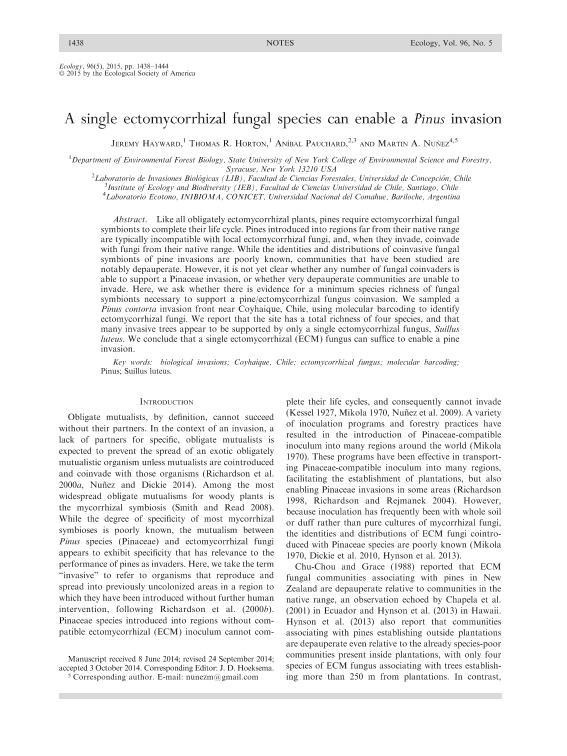Artículo
A single ectomycorrhizal fungal species can enable a Pinus invasion
Fecha de publicación:
05/2015
Editorial:
Ecological Society Of America
Revista:
Ecology
ISSN:
1939-9170
Idioma:
Inglés
Tipo de recurso:
Artículo publicado
Clasificación temática:
Resumen
Like all obligately ectomycorrhizal plants, pines require ectomycorrhizal fungal symbionts to complete their life cycle. Pines introduced into regions far from their native range are typically incompatible with local ectomycorrhizal fungi, and, when they invade, coinvade with fungi from their native range. While the identities and distributions of coinvasive fungal symbionts of pine invasions are poorly known, communities that have been studied are notably depauperate. However, it is not yet clear whether any number of fungal coinvaders is able to support a Pinaceae invasion, or whether very depauperate communities are unable to invade. Here, we ask whether there is evidence for a minimum species richness of fungal symbionts necessary to support a pine/ectomycorrhizal fungus coinvasion. We sampled a Pinus contorta invasion front near Coyhaique, Chile, using molecular barcoding to identify ectomycorrhizal fungi. We report that the site has a total richness of four species, and that many invasive trees appear to be supported by only a single ectomycorrhizal fungus, Suillus luteus. We conclude that a single ectomycorrhizal (ECM) fungus can suffice to enable a pine invasion.
Archivos asociados
Licencia
Identificadores
Colecciones
Articulos(INIBIOMA)
Articulos de INST. DE INVEST.EN BIODIVERSIDAD Y MEDIOAMBIENTE
Articulos de INST. DE INVEST.EN BIODIVERSIDAD Y MEDIOAMBIENTE
Citación
Hayward, Jeremy; Horton, Thomas R.; Pauchard, Aníbal; Nuñez, Martin Andres; A single ectomycorrhizal fungal species can enable a Pinus invasion; Ecological Society Of America; Ecology; 96; 5; 5-2015; 1438–1444
Compartir
Altmétricas




